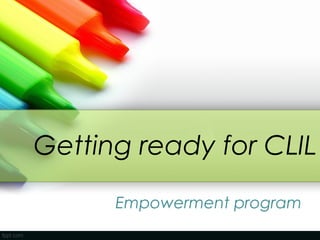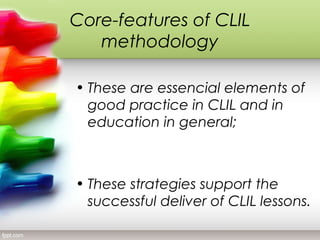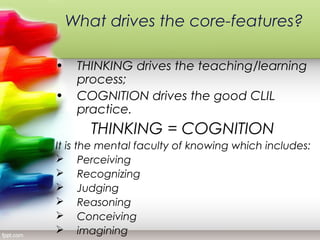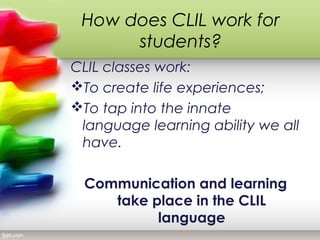Getting ready to use clil
- 1. Getting ready for CLIL Empowerment program
- 2. Activity 1. Mind map of the research article ? Divide the paper in the group. ? Establish the main factors of the paper. ? Summarize what you perceive as the main items of the paper. ? Present the map
- 3. Activity 2 Last class description: identify all the components of the class
- 4. The essence of CLIL ? Creating connections between learnersĄŊ lives and the content being taught in school; ? Learners will co-construct their understanding and learning. ? Ą°Learners learn to use the language and use the language to learnĄą ? CLIL recreates the conditions to which young children are exposed when they learn their first language.
- 5. CLIL environment ? It makes a childĄŊs language-learning potential work by providing: ? Rich INPUT ? Opportunities for rich INTAKE and OUTPUT ?BUT: not all INPUT becomes INTAKE ?CONSEQUENCE: limited opprotunities for output and learning will be HINDERED
- 6. What is and isnĄŊt unique about CLIL? ? Although CLIL is a new approach , it fits into the parametres of national or regional curriculum; ? It is a new approach that seeks to enrich the learning enviroment; ?It requieres a co-operation and skills exchange among language and content teachers; ?It requieres a colective agreement on common teaching strategies and students learning activities; ? An essencial step in CLIL implementation: Interdiciplinary fusion
- 7. Core-features of CLIL methodology ? These are essencial elements of good practice in CLIL and in education in general; ? These strategies support the successful deliver of CLIL lessons.
- 8. ?MULTIPLE FOCUS ?SAFE AND ENRICHING ENVIROMENT ?AUTHENTICITY ?ACTIVE LEARNING ?SCAFFOLDING ?CO-OPERATION
- 9. What drives the core-features? ? THINKING drives the teaching/learning process; ? COGNITION drives the good CLIL practice. THINKING = COGNITION It is the mental faculty of knowing which includes: ? Perceiving ? Recognizing ? Judging ? Reasoning ? Conceiving ? imagining
- 10. CLIL GOALS ?The holistic development of learners; ?To guide students towards becoming capable and motivated; ?To form independent students ?To put the focus on SUBSTANCE ?Not only provide with new information but also permit the connection between that new information and the existing knowldge, skills and attitudes.
- 11. CLIL MODEL ?MEANING-MAKING is both a personal and social process (COMUNITY) ?The new knowledge and skills develop through: ?Personal and cooperative reflection (COGNITION) ?A communicative process (COMMUNICATION)
- 12. THE FOUR PRINCIPLES ? These principles can serve as a reference point for lessons planning ? They contribute to successful outcomes COGNITION COMMUNITY ĻC CONTENT - COMMUNICATION
- 13. How does CLIL work for students? CLIL classes work: ?To create life experiences; ?To tap into the innate language learning ability we all have. Communication and learning take place in the CLIL language
- 14. CLIL lessons around the world ? http://www.youtube.com/watch? v=uAJSzSTUNT0&feature=related ? http://www.youtube.com/watch?v=-J- s_OCc8zw&feature=related ? http://www.youtube.com/watch? v=RYsG52Vw5do&feature=related ? http://www.youtube.com/watch? v=KsSGFsgWNVg&feature=related
- 15. Sources ? Book: Ą°Uncovering CLILĄą,by Peter Mehisto, Maria-Jesus Frigols, and David Marsh. (Chapter 2: Getting ready for CLIL) ? Youtube lessons














